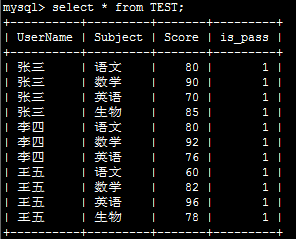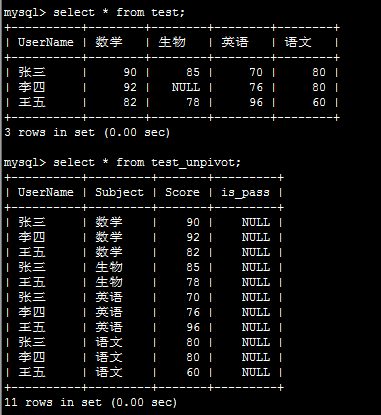示例:有如下表需要进行行转列:

代码如下:
|
1
2
3
4
5
6
7
8
9
10
11
12
13
14
15
16
17
18
19
20
21
22
23
24
25
26
27
28
29
30
31
32
33
34
35
36
37
38
39
40
41
42
43
44
45
46
47
48
49
50
51
52
53
54
55
56
57
58
59
60
61
62
63
64
65
66
67
68
69
70
71
72
73
74
75
76
77
78
79
80
81
82
83
84
85
86
87
88
89
90
91
92
93
94
95
96
97
98
99
100
101
102
103
104
105
106
107
108
109
110
111
112
113
114
115
116
117
118
119
120
121
122
123
124
125
126
127
|
# -*- coding:utf-8 -*-import pandas as pdimport MySQLdbfrom warnings import filterwarnings# 由于create table if not exists总会抛出warning,因此使用filterwarnings消除filterwarnings('ignore', category = MySQLdb.Warning)from sqlalchemy import create_engineimport sysif sys.version_info.major<3: reload(sys) sys.setdefaultencoding("utf-8") # 此脚本适用于python2和python3host,port,user,passwd,db,charset="192.168.1.193",3306,"leo","mysql","test","utf8" def get_df(): global host,port,user,passwd,db,charset conn_config={"host":host, "port":port, "user":user, "passwd":passwd, "db":db,"charset":charset} conn = MySQLdb.connect(**conn_config) result_df=pd.read_sql('select UserName,Subject,Score from TEST',conn) return result_df def pivot(result_df): df_pivoted_init=result_df.pivot('UserName','Subject','Score') df_pivoted = df_pivoted_init.reset_index() # 将行索引也作为DataFrame值的一部分,以方便存储数据库 return df_pivoted_init,df_pivoted # 返回的两个DataFrame,一个是以姓名作index的,一个是以数字序列作index,前者用于unpivot,后者用于save_to_mysql def unpivot(df_pivoted_init): # unpivot需要进行df_pivoted_init二维表格的行、列索引遍历,需要拼SQL因此不能使用save_to_mysql存数据,这里使用SQL和MySQLdb接口存 insert_sql="insert into test_unpivot(UserName,Subject,Score) values " # 处理值为NaN的情况 df_pivoted_init=df_pivoted_init.fillna(0) for col in df_pivoted_init.columns: for index in df_pivoted_init.index: value=df_pivoted_init.at[index,col] if value!=0: insert_sql=insert_sql+"('%s','%s',%s)" %(index,col,value)+',' insert_sql = insert_sql.strip(',') global host, port, user, passwd, db, charset conn_config = {"host": host, "port": port, "user": user, "passwd": passwd, "db": db, "charset": charset} conn = MySQLdb.connect(**conn_config) cur=conn.cursor() cur.execute("create table if not exists test_unpivot like TEST") cur.execute(insert_sql) conn.commit() conn.close() def save_to_mysql(df_pivoted,tablename): global host, port, user, passwd, db, charset """ 只有使用sqllite时才能指定con=connection实例,其他数据库需要使用sqlalchemy生成engine,engine的定义可以添加?来设置字符集和其他属性 """ conn="mysql://%s:%s@%s:%d/%s?charset=%s" %(user,passwd,host,port,db,charset) mysql_engine = create_engine(conn) df_pivoted.to_sql(name=tablename, con=mysql_engine, if_exists='replace', index=False) # 从TEST表读取源数据至DataFrame结构result_df=get_df()# 将源数据行转列为二维表格形式df_pivoted_init,df_pivoted=pivot(result_df)# 将二维表格形式的数据存到新表test中save_to_mysql(df_pivoted,'test')# 将被行转列的数据unpivot,存入test_unpivot表中unpivot(df_pivoted_init) |
结果如下:

关于Pandas DataFrame类自带的pivot方法:
DataFrame.pivot(index=None, columns=None, values=None):
Return reshaped DataFrame organized by given index / column values.
这里只有3个参数,是因为pivot之后的结果一定是二维表格,只需要行列及其对应的值,而且也因为是二维表格,unpivot之后is_pass列是肯定会丢失的,因此一开始我就没查这个列。
补充说明:
在学习到Pandas的层次化索引部分时发现了2个很有意思的函数,也可以进行行列互转,其用法如下:(很久之后我才意识到,pivot只是封装了unstack的一个快捷方式而已,其本质上还是先用set_index建立层次化索引,然后用unstack进行重塑,就像我在下面示例做的操作)
|
1
2
3
4
5
6
7
8
9
10
11
12
13
14
15
16
17
18
19
20
21
22
23
24
25
26
27
28
29
30
31
32
33
34
35
36
37
38
39
40
41
42
43
44
45
46
47
48
49
50
51
52
53
54
55
56
57
58
59
60
61
62
63
64
65
66
67
68
69
70
71
72
73
74
75
76
77
78
79
80
81
82
83
84
85
86
87
88
89
90
91
92
93
94
95
96
97
98
99
100
101
102
103
104
105
106
107
108
109
110
111
112
113
114
115
116
117
118
119
120
121
122
123
124
125
126
127
|
# -*- coding:utf-8 -*-import pandas as pdimport MySQLdbfrom warnings import filterwarnings# 由于create table if not exists总会抛出warning,因此使用filterwarnings消除filterwarnings('ignore', category = MySQLdb.Warning)from sqlalchemy import create_engineimport sysif sys.version_info.major<3: reload(sys) sys.setdefaultencoding("utf-8") # 此脚本适用于python2和python3host,port,user,passwd,db,charset="192.168.1.193",3306,"leo","mysql","test","utf8" def get_df(): global host,port,user,passwd,db,charset conn_config={"host":host, "port":port, "user":user, "passwd":passwd, "db":db,"charset":charset} conn = MySQLdb.connect(**conn_config) result_df=pd.read_sql('select UserName,Subject,Score from TEST',conn) return result_df def pivot(result_df): df_pivoted_init=result_df.pivot('UserName','Subject','Score') df_pivoted = df_pivoted_init.reset_index() # 将行索引也作为DataFrame值的一部分,以方便存储数据库 return df_pivoted_init,df_pivoted # 返回的两个DataFrame,一个是以姓名作index的,一个是以数字序列作index,前者用于unpivot,后者用于save_to_mysql def unpivot(df_pivoted_init): # unpivot需要进行df_pivoted_init二维表格的行、列索引遍历,需要拼SQL因此不能使用save_to_mysql存数据,这里使用SQL和MySQLdb接口存 insert_sql="insert into test_unpivot(UserName,Subject,Score) values " # 处理值为NaN的情况 df_pivoted_init=df_pivoted_init.fillna(0) for col in df_pivoted_init.columns: for index in df_pivoted_init.index: value=df_pivoted_init.at[index,col] if value!=0: insert_sql=insert_sql+"('%s','%s',%s)" %(index,col,value)+',' insert_sql = insert_sql.strip(',') global host, port, user, passwd, db, charset conn_config = {"host": host, "port": port, "user": user, "passwd": passwd, "db": db, "charset": charset} conn = MySQLdb.connect(**conn_config) cur=conn.cursor() cur.execute("create table if not exists test_unpivot like TEST") cur.execute(insert_sql) conn.commit() conn.close() def save_to_mysql(df_pivoted,tablename): global host, port, user, passwd, db, charset """ 只有使用sqllite时才能指定con=connection实例,其他数据库需要使用sqlalchemy生成engine,engine的定义可以添加?来设置字符集和其他属性 """ conn="mysql://%s:%s@%s:%d/%s?charset=%s" %(user,passwd,host,port,db,charset) mysql_engine = create_engine(conn) df_pivoted.to_sql(name=tablename, con=mysql_engine, if_exists='replace', index=False) # 从TEST表读取源数据至DataFrame结构result_df=get_df()# 将源数据行转列为二维表格形式df_pivoted_init,df_pivoted=pivot(result_df)# 将二维表格形式的数据存到新表test中save_to_mysql(df_pivoted,'test')# 将被行转列的数据unpivot,存入test_unpivot表中unpivot(df_pivoted_init) |
以上利用了Pandas的层次化索引,实际上这也是层次化索引一个主要的用途,结合本例我们可以把代码改成如下:
|
1
2
3
4
5
6
7
8
9
10
11
12
13
14
15
16
17
18
19
20
21
22
23
24
25
26
27
28
29
30
31
32
33
34
35
36
37
38
39
40
41
42
43
44
45
46
47
48
49
|
result_df=pd.read_sql('select UserName,Subject,Score from TEST',conn)# 在从数据库中获取的数据格式是这样的: UserName Subject Score0 张三 语文 80.01 张三 数学 90.02 张三 英语 70.03 张三 生物 85.04 李四 语文 80.05 李四 数学 92.06 李四 英语 76.07 王五 语文 60.08 王五 数学 82.09 王五 英语 96.010 王五 生物 78.0# 如果要使用层次化索引,那么我们只需要把UserName和Subject列设置为层次化索引,Score为其对应的值即可,我们借用set_index()函数:df=result_df.set_index(['UserName','Subject'])In [112]: df.unstack()Out[112]: Score Subject 数学 生物 英语 语文UserName 张三 90.0 85.0 70.0 80.0李四 92.0 NaN 76.0 80.0王五 82.0 78.0 96.0 60.0# 使用stack可以将unstack的结果转回来,这样就也在形式上实现了行列互转,之后的操作基本一致了。 |
以上就是本文的全部内容,希望对大家的学习有所帮助,也希望大家多多支持服务器之家。
原文链接:https://www.cnblogs.com/leohahah/p/9778304.html










